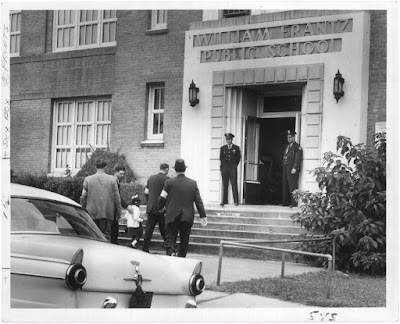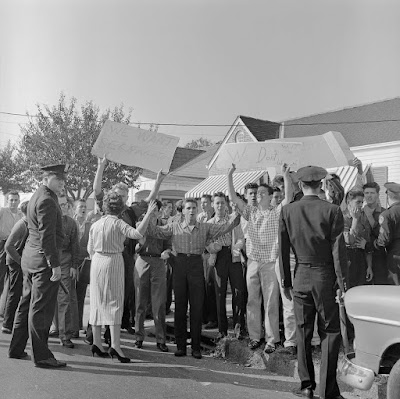Yesterday, in the midst of the larger outrage about Turnip and the Russians, my Twitter feed blew up about this cartoon:

That's Betsy DeVos, our new Secretary of Education, infantalized and shrunk down to child size and being protected by burly white men as she tried to enter a public school in Washington, D.C. the other day.
I recognized the reference to Norman Rockwell's painting The Problem We All Live With immediately, and shook my head:

This is what it actually looked like when DeVos tried to enter the school:

Note that she's accompanied by only one person, a black man, and he's shorter than she is. The people are not throwing things at her; they're blocking the entrance.
And this is what it looked like when Ruby Bridges tried to enter her school back in 1962:

The crowds were held back from the entrance:


(These photos are from Historical Photos. John Steinbeck was there that day in New Orleans. Some of his thoughts about it can be read here.)
The analyses that showed, in tweets or longer articles, why Glenn McCoy's cartoon is a vile piece of work followed soon after. (McCoy makes his money with stuff like this. Let's see... racist portrayals of Michelle Obama... ruminations on black-on-black crime... portraying Barack Obama as killing babies with a baseball bat... You get the idea. He keeps himself busy.)
What the cartoon made me think of, in addition to all of this, was my visit to the Norman Rockwell Museum late last summer. I never posted my photos at the time, but now here we are.

The museum is just outside Stockbridge, Massachusetts, which was long Rockwell's home.
My photo of The Problem We All Live With didn't turn out well, but I did get these two items on display that are much harder to find images of:

This is the tearsheet from Look magazine, and in the background the dress worn by Rockwell's model for the painting, Lynda Gunn. It's interesting that Rockwell chose a white dress, both for contrast and symbolizing innocence, when Bridges was never photographed that way.

The museum also displays these two studies of Gunn that Rockwell made before the final painting. (Note that he moved the bow from the top of her head in the studies to the back in the final painting. Interesting.) The writing on the lower right side of the study says this:
My very best wishes to one of my favorite models.Nearby in the museum is another painting named Moving In (New Kids in the Neighborhood), which was created a few years after The Problem We All Live With...
Lynda Jean Gunn
sincerely
Norman Rockwell

...which was also for Look magazine.
Rockwell's studio, which was moved to the grounds of the museum, is just down the hill from the main building. It was the last of several studios he built or used over the years; at least one of them had burned to the ground.
I didn't take a photo of the outside for some reason, but this is the inside:



The loft area was used to store paintings.
This photo by Louie Lamone, 1961, shows Rockwell working on his painting called The Connoisseur for the Saturday Evening Post (which ran in January 1962). It was shot from the loft, and shows him conferring with his son Peter as he works on the modern art painting-within-a-painting that is the focal point of the work:

I think this may have been one of Rockwell's last paintings to appear in the Post. He started working with Look magazine by 1963, which is when he painted The Problem We All Live With (which ran in January 1964).
Rockwell stopped working with the Post at least in part because (according to information on display at the museum) his contract prohibited him from showing black Americans in any way except as servants.
__
By the way, Ruby Bridges, who is just a few years older than Betsy DeVos, is on the board of directors of the Norman Rockwell Museum.


No comments:
Post a Comment